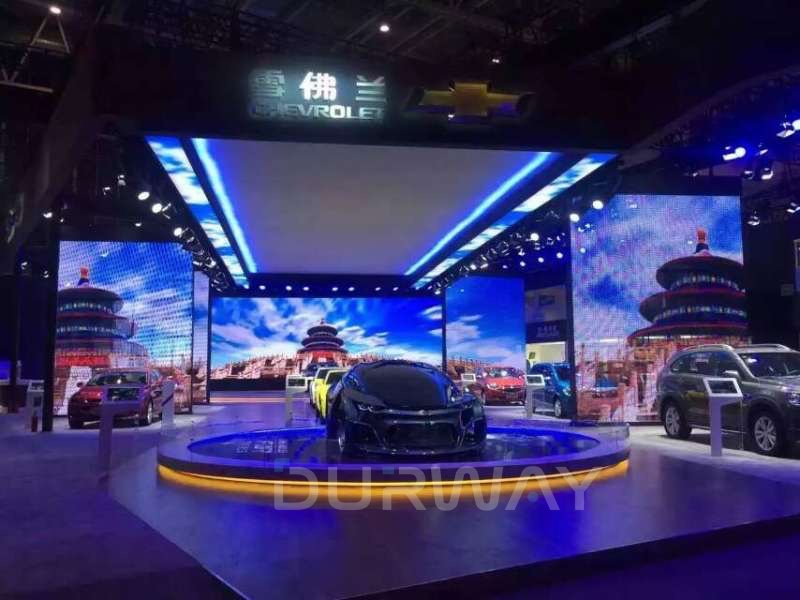COB LED Display
LED display technology has transformed the way we communicate and engage with visual content. Among the most prominent technologies are COB (Chip-on-Board) and SMD (Surface-Mounted Device). Both are widely used in LED displays, yet they differ significantly in terms of design, functionality, and application. This article delves into the basic principles and structural differences of COB and SMD technologies, providing insights to help you choose the right COB LED solution for your needs.
What is COB LED Display?
COB, or Chip-on-Board, is an advanced LED display that involves directly mounting multiple LED chips onto a substrate, creating a compact and seamless module. The chips are encapsulated with a layer of epoxy resin, which not only protects them but also enhances their durability and performance.

How COB Technology Works
- Chip Integration: Multiple LED chips are closely packed and bonded to a single PCB board.
- Protective Layer: A layer of epoxy resin or similar material is applied to protect the chips from physical damage, dust, and moisture. This will protect the parts of led tiles as well as the screen surface waterproof.
- Compact Design: The dense layout of chips eliminates the need for separate housing, creating a lightweight and space-efficient module.
- Structure: Either the led cabinet or frame, it will be necessary for led system to set up.
- Processors : Select the right processors for the led screen, like Novastar, Colorlight, or Brompton etc.
- System connection: COB LED screen will connect through data and power cables to work as a whole system.
Advantages of COB Technology
- Durability: The protective layer and compact design make COB modules highly resistant to damage.
- Heat Dissipation: COB displays dissipate heat more efficiently, ensuring stable performance over time.
- Smooth Visuals: The close proximity of the chips creates a uniform and seamless visual effect.
- Cost advantage: Once the product is mass produced, the cost and scale is very competitive.
What is SMD LED Technology?
SMD, or Surface-Mounted Device, is a more traditional LED technology where individual LED components (red, green, and blue diodes) are mounted separately onto a circuit board. These diodes are then soldered onto the board to form pixels.

How SMD Technology Works
- Individual LEDs: Each pixel consists of three diodes (red, green, blue) mounted on the PCB.
- Separate Housing: The LEDs are encased in separate housing, making the module slightly bulkier.
- Modular Design: SMD modules are designed for easy assembly and replacement.
- Structure: Either the led cabinet or frame, it will be necessary for led system to set up.
- Processors : Select the right processors for the led screen, like Novastar, Colorlight, or Brompton etc.
- System connection: SMD LED screen will connect through data and power cables to work as a whole system.
Advantages of SMD Technology
- High Resolution: SMD technology supports smaller pixel pitches, making it ideal for high-definition displays.
- Versatility: Suitable for both indoor and outdoor applications.
- Affordability: SMD modules are cost-effective, especially for larger projects.
- Color Uniformity: SMD led screens are doing with spectro-chromatic separation before packed.
Key Structural Differences Between COB and SMD
While both COB and SMD technologies are used in LED displays, their structural differences significantly impact their performance and application.
1. LED Arrangement
- COB: Multiple chips are placed directly onto the substrate, forming a dense and compact module, no wire needed.
- SMD: Individual LEDs are mounted separately onto the circuit board, with visible spacing between them with wire.
2. Pixel Density
- COB: Offers higher pixel density due to the close arrangement of chips, resulting in smoother visuals, the smaller <0.46mm.
- SMD: Allows for adjustable pixel pitches but generally has lower density compared to COB.
3. Durability
- COB: The protective layer over the chips makes COB displays more robust and resistant to damage.
- SMD: Exposed LEDs are more prone to physical damage and environmental wear.
4. Heat Management
- COB: Superior heat dissipation due to the direct chip-to-substrate bonding.
- SMD: Generates more heat in densely packed configurations, requiring additional cooling solutions
5. Visual Performance
- COB: Delivers smoother and more uniform visuals, especially in close-viewing scenarios.
- SMD: Provides sharp visuals but may show pixel separation in certain conditions.
6. Repair possibilities
- COB: It is not easy to repair by engineer, and it has to do with Machines, which take longer time.
- SMD: It is easy to see and repair by engineer, a trained or skillful person can do repairs, easier and shorter time return.
Applications of COB and SMD LED Technologies
The choice between COB and SMD depends on the specific requirements of the project. Here’s a comparison of their applications:
COB LED Applications
- Interactive Displays: Ideal for public spaces like museums and transportation hubs due to their durability.
- Close-Viewing Environments: Used in control rooms and high-end retail for smooth visuals.
- Control room: It needs to display the clear images and details with sharp visual.
- Broadcast Studio: It needs close look and better color reproduction, and robust.

SMD LED Applications
- Outdoor Displays: With higher brightness > 5500nits, it will used for the billboards etc.
- Indoor Displays: Frequently used for retail signage and corporate environments.
- Large-Scale Projects: Preferred for projects with cost constraints and larger viewing distances.
Choosing the Right COB LED Solution
When considering a COB LED solution, it’s essential to assess your project’s specific needs and priorities. Here are some factors to keep in mind:
Durability Requirements
If your project involves heavy traffic or harsh environments, COB technology is the better choice due to its protective layer and robust design.
Visual Quality
For projects requiring seamless visuals and high pixel density, COB is ideal. However, if sharpness and modularity are more critical, SMD may be a better fit.
Budget
COB modules can be more expensive initially, but their durability and performance may offer better value in the long run. SMD modules are more cost-effective for large-scale installations.
Future Trends in COB and SMD Technology
As LED technology advances, both COB and SMD are evolving to meet new demands. Emerging trends include:
- Smaller Pixel Pitches: Both technologies are pushing boundaries to offer finer resolutions.
- Improved Energy Efficiency: Manufacturers are focusing on reducing power consumption.
- Hybrid Solutions: Combining the best features of COB and SMD to create versatile displays.
| Feature | COB LED Screen | SMD LED Screen |
|---|
| Technology | Chip-on-board (COB) packaging with Ebony technology, using All Flip-chip design. | Surface-Mount Device (SMD) packaging. |
| Heat Dissipation | Excellent heat dissipation with wider heat dissipation area; up to 20% energy savings. | Standard heat dissipation with higher power consumption compared to COB. |
| Durability | Anti-collision, dustproof, waterproof, and non-holder design for extended lifetime. | Requires more protective designs and less robust under harsh conditions. |
| Color Performance | Wider color gamut with pixel-by-pixel calibration for higher color fidelity and uniformity. | Good color fidelity but less uniformity compared to COB. |
| Viewing Angle | Ultra-wide 170° horizontal and vertical viewing angle. | Typically narrower viewing angles. |
| Contrast Ratio | Higher contrast ratio due to advanced COB technology. | Lower contrast ratio. |
| Energy Efficiency | Common Cathode technology reduces power consumption by approximately 20% at the same brightness. | Higher power consumption for equivalent brightness levels. |
| Pixel Pitch | Fine pixel pitches available: 0.83mm, 1.25mm, and 1.66mm, supporting native 2K/4K resolutions. | Wider range of pixel pitches, but often less precise for ultra-fine resolutions. |
| Cost | Lower production cost due to integrated design. | Slightly higher production cost due to more complex assembly processes. |
| Maintenance | More difficult to repair due to integrated packaging; replacing individual components is challenging. | Easier to repair; individual LEDs can be replaced without affecting the surrounding area. |
| Application Scenarios | Ideal for high-end applications requiring fine pixel pitch, energy efficiency, and durability. | Commonly used for general-purpose displays with moderate resolution needs. |
Conclusion
COB and SMD technologies each offer unique benefits, catering to different project requirements. While COB is known for its durability, smooth visuals, and efficient heat management, SMD excels in high-resolution displays and cost-effectiveness. Understanding their key principles and structural differences will help you make an informed decision for your next LED project.
If you’re looking for a reliable and innovative COB LED solution, consider partnering with a trusted provider to ensure the best results. Whether it’s for interactive displays, outdoor advertising, or immersive indoor setups, COB technology continues to set new standards in the LED display industry.








